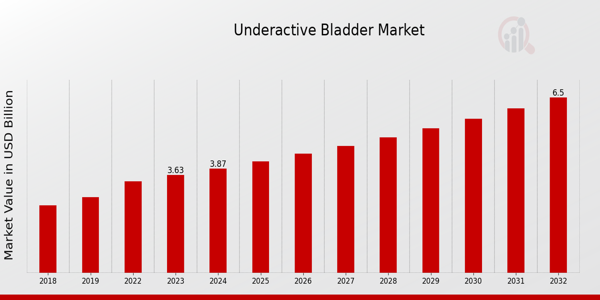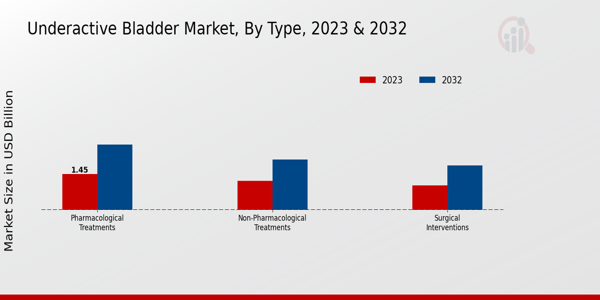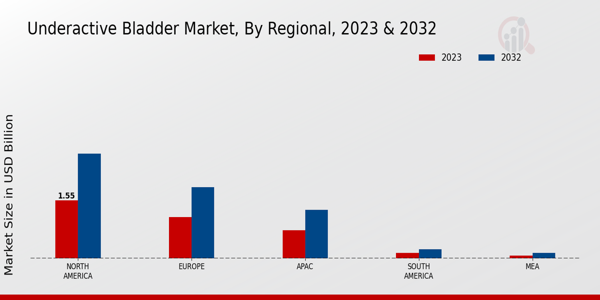Underactive Bladder Market Overview
As per MRFR analysis, the Underactive Bladder Market Size was estimated at 4.13 (USD Billion) in 2024. The Underactive Bladder Market Industry is expected to grow from 4.41 (USD Billion) in 2025 to 7.89 (USD Billion) till 2034, at a CAGR (growth rate) is expected to be around 6.69% during the forecast period (2025 - 2034).
Key Underactive Bladder Market Trends Highlighted
The underactive bladder market is witnessing significant growth driven by the increasing prevalence of bladder dysfunction, especially among the aging population. Awareness of underactive bladder conditions has improved, encouraging more individuals to seek diagnosis and treatment. Additionally, advancements in medical technology and the development of innovative therapies are enhancing patient outcomes. The growing focus on improving patient quality of life and the availability of a variety of treatment options, from lifestyle changes to surgical interventions, are further stimulating market expansion. Opportunities in the market include the increasing integration of telehealth services, which offer convenience for patients managing chronic bladder issues.Enhanced patient education and support through digital platforms can lead to higher engagement and adherence to treatment plans. Moreover, regions with developing healthcare infrastructure present untapped market potential as more individuals become aware of and have access to underactive bladder treatments. Recent trends indicate a rise in research and development aimed at creating less invasive treatment options, improving overall patient experience. There is an observable shift toward personalized medicine, where treatments are tailored to individual patient needs. Companies are also focusing on building strong collaborations with healthcare professionals to improve patient outcomes and satisfaction.Awareness campaigns for bladder health are becoming more prevalent, leading to increased diagnosis rates and subsequently expanding the patient pool. These dynamics are shaping the future of the underactive bladder market significantly.

Source Primary Research, Secondary Research, MRFR Database and Analyst Review
Underactive Bladder Market Drivers
Increasing Prevalence of Underactive Bladder Conditions
Firstly, the Underactive Bladder Market Industry is driven by the increasing hampered bladder activity disorders. Besides, growth in the elder population further hinders the investment climate. Similar conditions include underactive bladder, where the bladder does not fully empty out, leading to various consequences, including urinary tract infections and poor quality of life. In the previous years, however, more and more patients started seeking medical care due to the increased awareness of underactive bladder as a clinical problem.
It is this increase in awareness that accounts for the availability of various treatment options that vary diagnostic capabilities, leading to the growth of the market. At the same time, there is a trend at healthcare institutions to pay attention to bladder dysfunctions thus creating more investigation in the specific area and boosting the general growth of the Underactive Bladder Market Industry. With the increase in improvement of the diagnostic methods, early identification of the disorder is achievable which increases the treatment rates and subsequently increases the size of the market.
the Rising investment in healthcare infrastructure and a growing emphasis on patient-centered care are facilitating better management of underactive bladder, thus propelling the market further. The growing elderly population, particularly in developed regions, is another vital factor influencing the demand for treatments associated with underactive bladder. This demographic shift leads to a higher prevalence of pelvic floor disorders and neurogenic bladder conditions, creating a pressing need for effective solutions that the Underactive Bladder Market Industry can provide.Overall, awareness, diagnostic improvements, and demographic trends contribute significantly to this market's expansion, indicating a robust future for underactive bladder treatments.
Advancements in Treatment Options
Technological advancements in treatment options for underactive bladder play a crucial role in propelling the Underactive Bladder Market Industry. Innovative therapies and devices such as neuromodulation techniques, catheterization, and pharmaceutical solutions have emerged, drastically changing the landscape for managing this condition. This increased variety allows healthcare professionals to tailor treatments to individual patient needs, fostering better outcomes.Emerging treatment modalities enhance patient compliance and satisfaction, making a significant impact on market growth.
Growing Awareness and Education
The growing awareness and education regarding underactive bladder significantly contribute to the growth of the Underactive Bladder Market Industry. Efforts to improve public knowledge about this condition have led to more individuals recognizing symptoms and seeking medical advice. Workshops, seminars, and awareness campaigns are helping educate healthcare providers and patients alike about available treatments. Increased understanding of urinary disorders is essential for early diagnosis and treatment, fueling market demand.
Underactive Bladder Market Segment Insights
Underactive Bladder Market Type Insights
Bladder Market presents a comprehensive landscape, classified into various types, reflecting a structured approach to addressing this medical condition. As of 2023, the total market value stands at 3.63 USD Billion, showcasing a growing sector that addresses the needs of patients suffering from underactive bladder issues. Within this market, the categorization into Pharmacological Treatments, Non-Pharmacological Treatments, and Surgical Interventions reveals distinct roles in patient management that significantly contribute to the overall market growth.
The Underactive Pharmacological Treatments had a valuation of 1.45 USD Billion in 2023, making it a predominant category in the segment. This type is critical as it involves the use of medications to improve bladder function, thereby representing a significant share of the Underactive Bladder Market revenue. The increasing prevalence of urinary disorders and the rising demand for effective treatment options significantly fuel the growth of this category, positioning it as a leader in this market.Non-Pharmacological Treatments also play a vital role, recorded at 1.18 USD Billion in 2023. This treatment avenue, which includes behavioral therapies and pelvic floor exercises, addresses the underlying issues of underactive bladder in a holistic manner. The rising patient preference for non-invasive treatment options and better awareness regarding lifestyle modifications are key factors contributing to the growth of this segment, making it an essential component of the Underactive Bladder Market segmentation.On the other hand, Surgical Interventions, although valued at 1.0 USD Billion, have become an increasingly important option for patients with severe symptoms. Surgical options tend to dominate when other treatments fail, highlighting their significance in the complete management plan for underactive bladder. With advancements in surgical techniques and a better understanding of the condition, this area of the market is poised for growth, further contributing to the market statistics. The diversity of treatment options within the Underactive Bladder Market signifies multiple pathways to patient recovery and emphasizes the importance of tailored approaches in improving the quality of life for individuals affected by this condition. As the industry continues to evolve, the unique characteristics and values of each treatment type showcase vast opportunities for innovative products and solutions, addressing both market demands and patient needs, thus underscoring a robust potential for sustained market growth in the coming years.

Source Primary Research, Secondary Research, MRFR Database and Analyst Review
Underactive Bladder Market End User Insights
The Underactive Bladder Market, valued at 3.63 billion USD in 2023, witnesses varied utilization across different end-user categories. Hospitals serve as a crucial touchpoint for comprehensive treatment and advanced care, attracting a significant share of patients due to their ability to provide specialized diagnostic and therapeutic interventions. Clinics, on the other hand, play an essential role in outpatient management, offering accessible services for patients requiring ongoing care, which fosters patient engagement and convenience. Homecare settings have gained importance as they align with the growing preference for at-home treatments, enabling patients to manage their conditions in a comfortable environment.This growing trend towards home care reflects a broader shift in patient care dynamics. Overall, these end-user segments contribute substantially to the market growth and demonstrate emerging opportunities for tailored solutions within the Underactive Bladder Market industry, driven by the need for effective and patient-centric management strategies. The Underactive Bladder Market data indicates that the evolving landscape presents both challenges and opportunities for innovation in service delivery and care approaches.
Underactive Bladder Market Category Insights
The Underactive Bladder Market is poised for continued growth, with a market revenue projected to reach 3.63 billion USD in 2023. This market is diverse and includes various categories, such as Overactive Bladder Medications, Neuromodulation Devices, and Supportive Therapies. Overactive Bladder Medications play a crucial role in addressing the needs of patients with bladder dysfunction and significantly contributing to market dynamics. Neuromodulation Devices are increasingly recognized for their efficacy in managing symptoms, making them a significant category due to their novel approach to treatment.Additionally, Supportive Therapies are essential as they provide a multi-faceted approach to care, enhancing patient outcomes. The market's segmentation illustrates the growing demand for comprehensive treatment options in managing underactive bladder symptoms, with individual categories showing unique contributions to market growth. The overall Underactive Bladder Market data reflects an increasing awareness of treatment solutions, with studies highlighting the need for innovation in supportive care strategies. Market growth is further driven by advancements in technology and an increasing patient population, strengthening the industry's potential.
Underactive Bladder Market Gender Insights
The Underactive Bladder Market, valued at 3.63 USD Billion in 2023, showcases significant segmentation by Gender, primarily categorized into Male and Female. This market reflects a growing recognition of underactive bladder conditions affecting both genders, with both segments contributing to the overall market growth. Male patients often experience underactive bladder issues due to various factors, including prostate conditions, which highlight the need for tailored treatment options. Conversely, females face unique challenges associated with neurological conditions, pelvic floor dysfunction, and post-menopausal changes, leading to a growing demand for effective management solutions.Gender-specific insights reveal important trends where targeting the male and female demographics with distinct treatment approaches can optimize outcomes and improve patients' quality of life. The data indicates that addressing the unique needs of both segments creates opportunities for healthcare providers, enhancing the Underactive Bladder Market revenue. As awareness increases and treatment options become more diversified, the Underactive Bladder Market segmentation continues to evolve, responding to the specific health concerns presented by each gender in the pursuit of effective management for this condition.
Underactive Bladder Market Age Group Insights
The Underactive Bladder Market revenue is projected to grow significantly, influenced by varied needs across different age groups. Children, although not the largest demographic, represent a critical focus area due to the increasing awareness of urinary health conditions early in life, fostering the need for specialized treatments. Adults constitute a substantial portion of the market, driven by lifestyle factors and the rising prevalence of urinary disorders, making their needs a priority for product development. In contrast, the elderly population significantly dominates this market segment, accounting for a major share; this is largely due to age-related physiological changes that increase the incidence of underactive bladder conditions.The interplay of these age groups reflects distinct patient requirements, thus highlighting the importance of tailored approaches in treatment and management within the Underactive Bladder Market segmentation. Market growth will be supported by advancements in treatment options and a growing understanding of bladder health across all age demographics. However, challenges such as awareness and stigma around these conditions pose hurdles for the market, which is useful for developing opportunities in targeted education and awareness initiatives. The interplay of these factors determines growth dynamics in the Underactive Bladder Market Statistics, influencing future strategies in this sector.
Underactive Bladder Market Regional Insights
The Underactive Bladder Market is valued at approximately 3.63 USD Billion in 2023, showcasing a growing demand for solutions in this area. Within the Regional segment, North America holds a significant portion of the market with a valuation of 1.55 USD Billion, projected to rise to 2.8 USD Billion by 2032, indicating its majority holding in the market landscape due to advanced healthcare infrastructure and increasing awareness. Europe follows with a valuation of 1.1 USD Billion in 2023, expected to grow to 1.9 USD Billion by 2032, benefitting from robust healthcare systems and increasing geriatric population.The APAC region, currently valued at 0.75 USD Billion, anticipates a rise to 1.3 USD Billion, propelled by rising healthcare accessibility and a growing market for urological products. Meanwhile, South America and the MEA represent smaller segments, valued at 0.15 USD Billion and 0.08 USD Billion, respectively, in 2023. These regions, while showing modest valuations projected to reach 0.25 USD Billion and 0.15 USD Billion by 2032, are driven by improving healthcare infrastructure but may face challenges related to access and awareness. Overall, the Underactive Bladder Market segmentation reveals differentiated growth opportunities across regions, primarily influenced by economic conditions and healthcare developments.

Source Primary Research, Secondary Research, MRFR Database and Analyst Review
Underactive Bladder Market Key Players and Competitive Insights
The Underactive Bladder Market has been evolving steadily, driven by an increasing awareness of underactive bladder conditions and their impact on the quality of life for affected individuals. As healthcare professionals and patients alike recognize the importance of managing this condition, competition in the market has intensified. Various pharmaceutical companies are investing in research and development to provide innovative solutions and effective treatments for underactive bladder syndrome. This competitive landscape is characterized by a mix of established players and emerging firms that are focusing on novel therapies and technologies, emphasizing the need for differentiation and improved patient outcomes. As a result, market dynamics are constantly shifting, with companies striving to enhance their product offerings, maximize their market share, and address the needs of diverse patient populations.Bayer has established a significant presence in the Underactive Bladder Market, driven by its commitment to research and innovation. The company leverages its extensive experience in healthcare and pharmaceuticals to develop therapies that target underactive bladder symptoms effectively. Bayer's strengths lie in its robust research and development framework, which allows the company to stay ahead of emerging trends and continuously optimize its product lines. The company's established distribution channels and strong relationships with healthcare providers further bolster its market position. Moreover, Bayer's focus on safety and efficacy in its product development enhances its reputation among patients and healthcare professionals, making it a trusted name in the management of underactive bladder conditions. This combination of innovation, strong market presence, and a commitment to patient care positions Bayer as a formidable competitor in this space.Eli Lilly has carved out a notable reputation in the Underactive Bladder Market through its dedication to addressing urological conditions with an emphasis on quality and patient-centric solutions. The company's strengths include a comprehensive pipeline of treatment options that focus not only on mitigating symptoms but also on improving the overall quality of life for patients suffering from underactive bladder. Eli Lilly's extensive research initiatives and partnerships with healthcare professionals enhance its ability to bring forth safe and effective medications. Its established brand equity and trust within the healthcare community allow for the effective dissemination of information regarding its products, further strengthening its competitive edge. The company's ongoing commitment to understanding patient needs and advancing therapeutic options solidifies Eli Lilly's role as a key player in this growing market.
Key Companies in the Underactive Bladder Market Include
- Bayer
- Eli Lilly
- Meda Pharmaceuticals
- Hikma Pharmaceuticals
- Santen Pharmaceutical
- Novartis
- AbbVie
- Teva Pharmaceuticals
- Astellas Pharma
- Sun Pharmaceutical
- Otsuka Pharmaceutical
- Boehringer Ingelheim
- Pfizer
- Helsinn Healthcare
- Ferring Pharmaceuticals
Underactive Bladder Market Industry Developments
The Underactive Bladder Market is witnessing significant developments as key players like Bayer, Eli Lilly, and Novartis focus on expanding their product portfolios and enhancing treatment options. Recently, Meda Pharmaceuticals has introduced new formulations aimed at improving patient compliance, while Hikma Pharmaceuticals is investing in research to better understand the mechanisms underlying underactive bladder. Current market trends indicate an increased demand for innovative therapies, with Santen Pharmaceutical and Teva Pharmaceuticals working collaboratively on clinical trials to evaluate novel solutions. In terms of mergers and acquisitions, there have been strategic alignments, as AbbVie acquired a smaller biotech firm to bolster its capabilities in this field. Additionally, companies such as Boehringer Ingelheim and Pfizer are exploring partnerships to leverage their respective strengths in drug development. The market is also experiencing growth in valuation, driven by rising awareness and an aging population, significantly impacting companies like Astellas Pharma and Sun Pharmaceutical as they navigate regulatory pathways for new treatments. Ferring Pharmaceuticals is focused on expanding its geographic presence and responding to the evolving needs in the underactive bladder market landscape. These dynamics are shaping a competitive environment that is vital for advancing therapeutic options and improving patient outcomes.
Underactive Bladder Market Segmentation Insights
- Underactive Bladder Market Type Outlook
- Pharmacological Treatments
- Non-Pharmacological Treatments
- Surgical Interventions
- Underactive Bladder Market End User Outlook
- Hospitals
- Clinics
- Homecare Settings
- Underactive Bladder Market Category Outlook
- Overactive Bladder Medications
- Neuromodulation Devices
- Supportive Therapies
- Underactive Bladder Market Gender Outlook
- Male
- Female
- Underactive Bladder Market Age Group Outlook
- Children
- Adults
- Elderly
- Underactive Bladder Market Regional Outlook
- North America
- Europe
- South America
- Asia Pacific
- Middle East and Africa
| Report Attribute/Metric |
Details |
|
Market Size 2024
|
4.13 (USD Billion)
|
|
Market Size 2025
|
4.41 (USD Billion)
|
|
Market Size 2034
|
7.89 (USD Billion)
|
|
Compound Annual Growth Rate (CAGR)
|
6.69 % (2025 - 2034)
|
|
Report Coverage
|
Revenue Forecast, Competitive Landscape, Growth Factors, and Trends
|
|
Base Year
|
2024
|
|
Market Forecast Period
|
2025 - 2034
|
|
Historical Data
|
2020 - 2024
|
| Market Forecast Units |
USD Billion |
| Key Companies Profiled |
Bayer, Eli Lilly, Meda Pharmaceuticals, Hikma Pharmaceuticals, Santen Pharmaceutical, Novartis, AbbVie, Teva Pharmaceuticals, Astellas Pharma, Sun Pharmaceutical, Otsuka Pharmaceutical, Boehringer Ingelheim, Pfizer, Helsinn Healthcare, Ferring Pharmaceuticals |
| Segments Covered |
Type, End User, Category, Gender, Age Group, Regional |
| Key Market Opportunities |
Rising geriatric population, Increased awareness campaigns, Innovative treatment technologies, Expansion of telemedicine solutions, Growing demand for individualized therapies |
| Key Market Dynamics |
Increasing prevalence of urinary disorders, Growing awareness of treatment options, Advancements in medical technologies, Rising geriatric population, Enhanced focus on patient quality of life |
| Countries Covered |
North America, Europe, APAC, South America, MEA |
Frequently Asked Questions (FAQ) :
The Underactive Bladder Market is expected to be valued at 6.5 billion USD by 2034.
The expected CAGR for the Underactive Bladder Market from 2025 to 2034 is 6.69%.
North America is anticipated to hold the largest market share, valued at 2.8 billion USD by 2034.
The market size for Pharmacological Treatments is expected to reach 2.65 billion USD by 2034.
Major players in the market include Bayer, Eli Lilly, Meda Pharmaceuticals, Novartis, and Pfizer.
The market size for Non-Pharmacological Treatments is expected to be valued at 2.04 billion USD by 2034.
Surgical Interventions are expected to reach a market size of 1.81 billion USD by 2034.
The market for Underactive Bladder in the APAC region is expected to be valued at 1.3 billion USD by 2032.
The market could face challenges related to regulatory hurdles and competition among existing treatments.
The estimated market size for South America is expected to reach 0.25 billion USD by 2032.





























